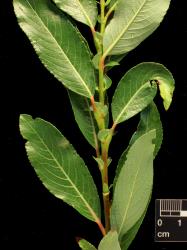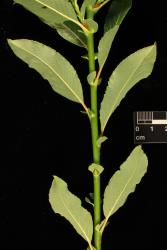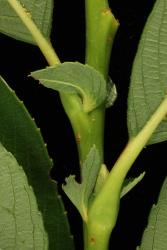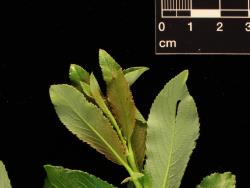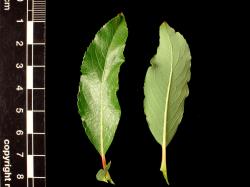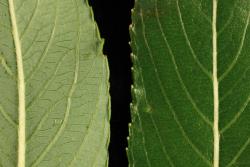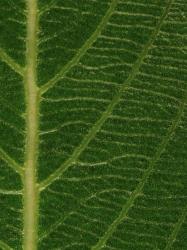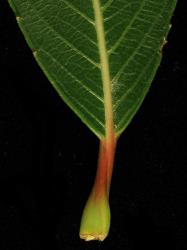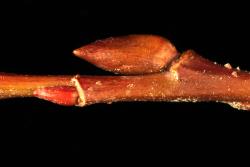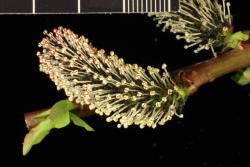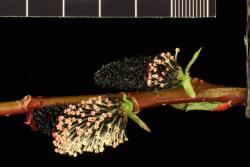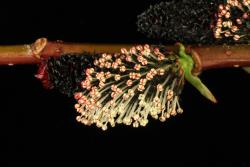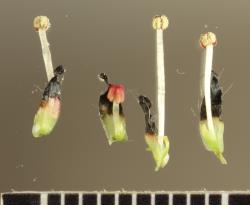Erect shrub. Current year's branchlets greyish pink (UCL32), hairs dense, long-silky but erect, or glabrous and mid-brown (UCL58) in 'Melanostachys'. Year-old branchlets moderate red to mid-brown (UCL15–58), glabrous, 3.9–4.5 mm diameter. Flower bud scales 11–12 mm long, 5.0–5.5 mm wide, 3.8–4.5 mm deep, ovoid with a distinct apical beak, red-brown (UCL43), glabrous, membranous. Leaves alternate. Stipule persistent, 8–10 mm long, ovate. Petiole 6–7 mm long, densely tomentose on all aspects (glabrous in 'Melanostachys'), base bulbous, glands absent. Emerging leaves tinted slightly orange, very densely long-silky hairy on both surfaces (glabrous in 'Melanostachys'). Leaf lamina 63–100 mm long, 19–32 mm wide, length to width ratio 3.1–3.6:1, rectangular-obovate, not falcate; base rounded; apex acute and acuminate; leaf galls absent; margins finely revolute, teeth marginal; upper lamina surface sparsely long-silky hairy to glabrous, medium-glossy, stomata dense; lower lamina surface densely long-silky hairy (glabrous in 'Melanostachys'), midvein and side-veins raised, netted veins visible, distinctly glaucous. Catkins male, emergence precocious to simultaneous with leaves. Flowering branch 29–52 mm long with 3 reduced leaves. Male catkin 34–47 mm long, 11–15 mm diameter; catkin rachis not visible between flowers. Flower bract 5.8–6.0 mm long, 1.5–1.9 mm wide, whole bract initially red, at anthesis the distal half black, middle section red, base pale green, flat; apex acute, margins very sparsely long-silky hairy. Male nectary 1, 1.2–1.5 mm long, 0.4–0.5 mm wide, yellow. Stamen filaments fused to a single filament that divides between the anthers, filament hairs absent; anthers 0.9–1.0 mm long, red.
Anthers are united at the end of a single filament per flower as in Salix purpurea. The flower bud scale is also very similar to that of S. purpurea in being beaked and membranous.
The leaves, flower bud scales, branchlets, and flower bracts of Salix gracilistyla in New Zealand are usually densely hairy. However, PN657 at Aokautere is almost glabrous from time of leaf emergence. It belongs to cultivar 'Melanostachys' and was imported to New Zealand in 1975 under this name. Kuzovkina (2015) described this cultivar as "A very unusual male cultivar, possibly of garden origin, with black not-silky catkins, glabrous black bracts and red anthers turning yellow at maturity. Leaves and branches are glabrous," and mentioned that "Dirr (2009) suggests that this taxon is a hybrid". 'Melanostachys' is very similar to Salix daphnoides in leaf size and shape; the red petiole, which is swollen at the base; and stipule size and shape. Salix gracilistyla lacks the waxy bloom on branchlets that S. daphnoides has, and the catkins of S. gracilistyla look very different in having bicoloured flower bracts and united stamen filaments.
Auckland (Albany 1972), Gisborne (Waioeka Gorge 1978, Eastwoodhill Arboretum 1965).
A single wild record at Eastwoodhill Arboretum.
First collection: CHR 369532, W. R. Sykes, January 1965, Gisborne, Eastwood Hill Arboretum.
First publication: Sykes (1982).
Flowering: Mid-September.
Diploid, 2n = 38 (Ohashi 2006) provisionally confirmed by flow cytometry using PN657.



